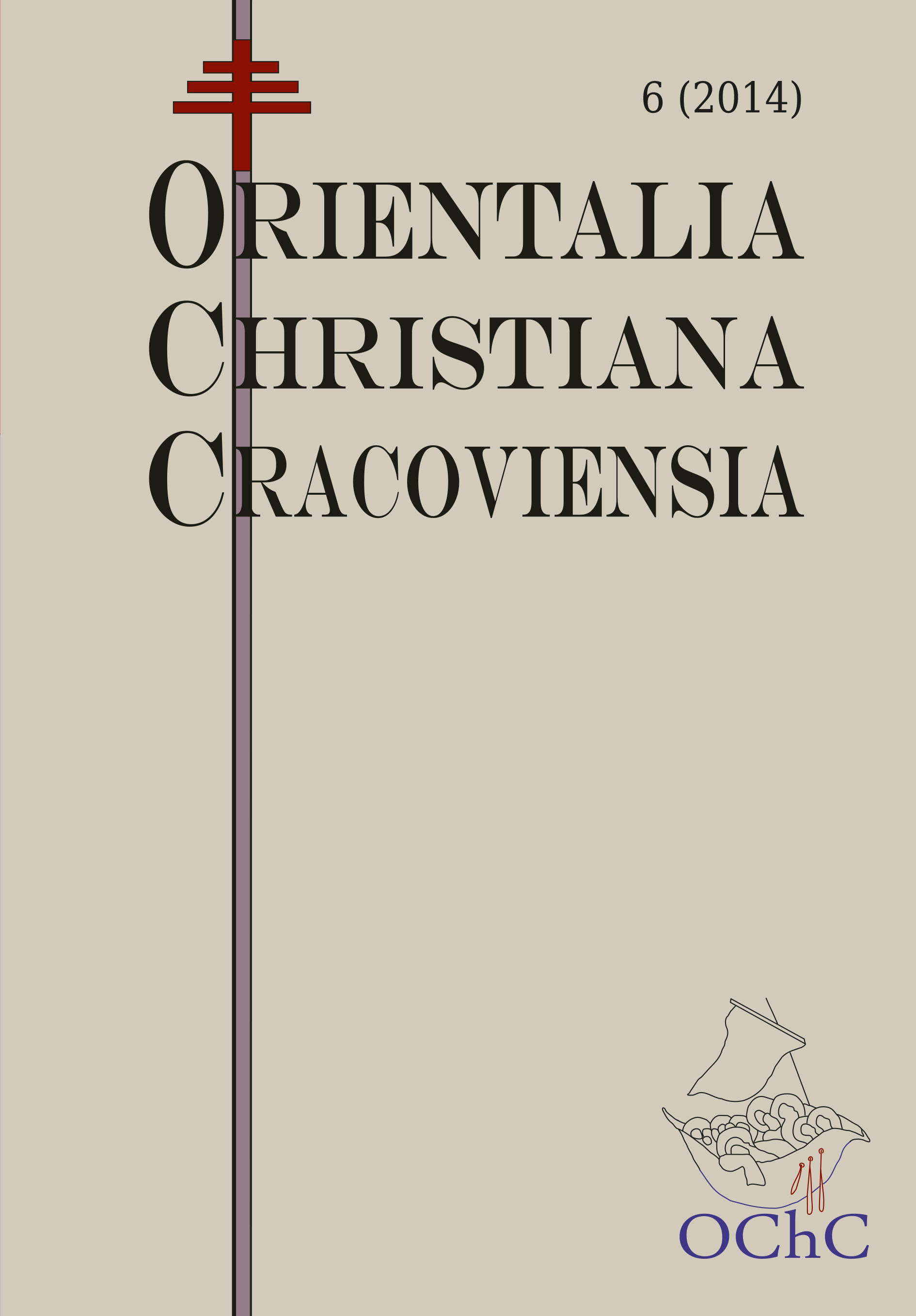The “Arab Spring” and the Christian Linguistic Minorities in Syria
DOI:
https://doi.org/10.15633/ochc.1105Keywords:
Syria, “Arab Spring”, linguistic minorities, ChristiansAbstract
Syria has a heterogeneous population. It reflects the complicated history of the region and constitutes evidence for many migratory waves, that have been coming to Syria for centuries.The linguistic situation of Syria is less complicated, however also here the heterogeneity is observable. The official language of Syria is Modern Standard Arabic. Nevertheless, because of the diglossia being a common state in Arab countries, this language has no use in a daily communication. This role is performed by vernacular dialects of Arabic. In western Syria are spoken the Levantine and in al-Jazira the Mesopotamian dialects. The Kurds usually speak Kurmanji, which belongs to the Iranian languages. Moreover other small linguistic communities (e.g. Adyghe, Kabardian, Turkish) exist. As far as the Christian non-Arab linguistic minorities are concerned, in 2011 it was possible to indicate speakers of four main languages: Western Aramaic, Suret, Turoyo, Armenian.
References
Adalian R., Historical Dictionary of Armenia, Scarecrow Pres Inc. 2010.
Arnold W., Die Aramäer in Europa auf der Suche nach einer Standardsprache, [in:] Sprache und Migration, ed. U. Maas, Osnabrück 2005, p. 77–88.
Awde N., Lamassu N., Al-Jeloo N., Aramaic, Modern Dictionary & Phrasebook, Hippokrene Books 2007.
Bar Sh., Bashar’s Syria: The Regime and its Strategic Worldview, “Comparative Strategy” 25 (2007), p. 353–445.
Britain D., Geolinguistics – Diffusion of Language, [in:] Sociolinguistics. An International Handbook of the Science of Language and Society, eds. U. Ammon et al., vol. 1, Berlin 2004, p. 34–48.
Cambridge Handbook of Endangered Languages, eds. P. K. Austin, J. Sallabank, Cambridge 2011.
Cutts E., Christians under the Crescent in Asia, London–New York 1877.
Châtel F. de, The Role of Drought and Climate Change in the Syrian Uprising: Untangling the Triggers of the Revolution, “Middle Eastern Studies” 50 (2014) Issue 4, p. 521–535, http://dx.doi.org/10.1080/00263206.2013.850076.
Giovanni J. di, Gaffey C., The New Exodus. Christians Flee ISIS in the Middle East, “Newsweek” April 03, 2015, p. 24–33.
El-Issawi F., The Arab Spring and the Challenge of Minority Rights: Will the Arab Revolutions Overcome the Legacy of the Past?, “European View” 10 (2011), p. 249–258.
Fergusson Ch., Diglossia, „Word” 15 (1959), p. 325–340.
Giannini A., Le costituzioni degli stati del vicino oriente, Roma 1931.
Glass Ch., The Country That Is the World. Syria’s Clashing Communities, “World Affairs” July/August, 2012, p. 85–91.
Gracey G. Y., Armenian Settlement in Syria, “Contemporary Review” 140 (1931), p. 85–93.
Hourani A., Minorities in the Arab World, New York 1947.
Jastrow O., The Turoyo Language Today, “Journal of Assyrian Academic Studies” 1 (1987), p. 7–16.
Markosian D., Armenia Tries to Help as Christian Armenians Flee Syria, “USA Today” February 14, 2013, http://www.usatoday.com/story/news/world/2013/02/13/syria-fighting-refugees/1917473/.
Migliorino N., (Re)constructing Armenia in Lebanon and Syria: Ethno-cultural Diversity and the State in the Aftermath of a Refugee Crisis, New York 2008.
Moseley Ch., Encyclopedia of World’s Endangered Languages, New York 2007.
Nelson D., Language Death, [in:] The Routledge Companion to Sociolinguistics, eds. C. Llamas, L. Mullany, P. Stockwell, New York 2004, p.199–204.
Owens J., Endangered Languages of the Middle East, [in:] Language Diversity Endangered, ed. M. Brezinger, Berlin–New York 2007, p. 263–277.
Payaslian S., Diasporan Subalternities: The Armenian Community in Syria, “Diaspora: A Journal of Transnational Studies” 16 (2007) No. 1/2, p. 92–132, http://dx.doi.org/10.1353/dsp.2007.0009.
Pennycook A., Language Policy and the Ecological Turn, “Language Policy” 3 (2004) No. 3, p. 213–239, http://dx.doi.org/10.1007/s10993-004-3533-x.
Reynolds G. S., The Devil They Know. Why Most Syrian Christians Support Bashar al-Assad, “Commonwealth” September 13, 2013, p. 10–11.
Salameh F., Adonis, the Syrian Crisis, and the Question of Pluralism in the Levant, “Bustan: The Middle East Book Review” 3 (2012), p. 36–61.
Selimian H., A Message from Rev. Haroutune Selimian, “International Congregational Journal”10 (2011) Issue 2, p. 9.
Shea N., Barbarism 2014. On Religious Cleansing by Islamists, “World Affairs“ November/December, 2014, p. 34–46.
Talay Sh., Die neuaramäischen Dialekte der Khabur-Assyrer in Nordostsyrien. Einführung, Phonologie und Morphologie, Wiesbaden 2008.
Żebrowski J., Dzieje Syrii od czasów najdawniejszych do współczesności, Warszawa 2006.
Downloads
Published
Issue
Section
License
Twórca oświadcza, że przysługują mu prawa autorskie do utworu i że nie są ograniczone w zakresie objętym niniejszym oświadczeniem oraz że utwór jest dziełem oryginalnym i nie narusza praw autorskich innych osób.
Twórca zezwala Uniwersytetowi Papieskiemu Jana Pawła II w Krakowie na nieodpłatne, niewyłączne i nieograniczone w czasie korzystanie z utworu, to jest:
- utrwalanie i zwielokrotnianie: wytwarzanie egzemplarzy utworu techniką drukarską, reprograficzną, zapisu magnetycznego oraz techniką cyfrową;
- obrotu oryginałem albo egzemplarzami, na których utwór utrwalono (wprowadzanie do obrotu, użyczenie lub najem oryginału albo egzemplarzy, publiczne wystawienie, wyświetlenie, a także publiczne udostępnianie utworu w taki sposób, aby każdy mógł mieć do niego dostęp w miejscu i w czasie przez siebie wybranym);
- włączenie utworu w skład utworu zbiorowego;
- udzielanie przez Uniwersytet Papieski Jana Pawła II w Krakowie sublicencji Creative Commons Uznanie autorstwa-Użycie niekomercyjne-Bez utworów zależnych 3.0 Polska
Uniwersytet Papieski Jana Pawła II w Krakowie udostępnia utwór na Platformie Czasopism należącej do uczelni, na licencji Creative Commons Uznanie autorstwa-Użycie niekomercyjne-Bez utworów zależnych 3.0 Polska. Tym samym uprawnia wszystkich zainteresowanych do korzystania z utworu pod następującymi warunkami:
- zostanie podany autor i tytuł utworu,
- zostanie podane miejsce publikacji (tytuł czasopisma i adres internetowy do oryginalnie opublikowanego utworu),
- utwór będzie dystrybuowany w sposób niekomercyjny,
- nie będą tworzone utwory zależne.

